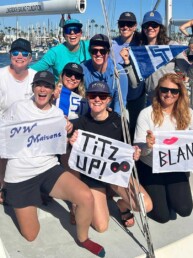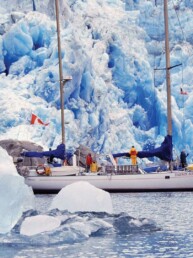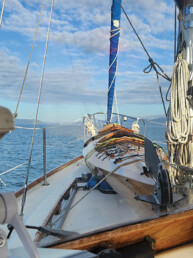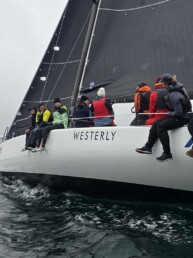From the November 2020 issue of 48° North
48° North: Steve Callahan may be familiar to many 48° North readers. He’s the award winning author of the book, Adrift: 76 Days Lost at Sea. He is renowned as an expert about survival at sea, but also has 50-plus years of experience around boats — designing, building, and voyaging.
Steve: What was Rat’s quote in The Wind in the Willows? “Believe me, my young friend, there is nothing — absolutely nothing — half so much worth doing as simply messing about in boats.” By that measure, I guess I’ve had a very worthwhile life. I’ve been very fortunate, most of all, because this meandering, serendipitous path of my life has led me to meet a great number of incredible sailors, designers, builders, and adventurers. So I feel very lucky about that.
Please tell us about your background as a naval architect.
My father was an architect, so I grew up drawing. You develop sort of a three-dimensional eyeball looking at two-dimensional plans — you can envision it. I remember writing a letter to the late, great Gary Mull. Here I was, this kid of maybe 13 asking, “How do I get into designing boats?” He was so kind to send me a response. Gary said, at the time, that there was Westlawn [Institute of Marine Technology], the University of Michigan, or MIT; the latter of which was mostly specializing in large ships. I didn’t really pursue that. I got out of school and stumbled into helping people build boats as part of the ‘back to the land’ movement. Jim Brown, father of legendary Port Townsend builder and designer Russell Brown, coined the term “Seasteading,” which suited that era too because a lot of people were building their own boats. I had enough skill, not great skill, to help out in that regard.
I really stumbled into boat building. When I moved to Maine, I had done a little catamaran design. A local designer, Bob Ballstrom — who had been partners with Ted Brewer — was running Yacht Design Institute (YDI), which was a competitor to Westlawn. He hired me, and I worked with Bob and YDI off and on for about ten years. I worked with designers as we developed the school, writing texts, helping edit and publish, correcting papers, all while doing my own designs on the side and finishing Bob’s.
I don’t consider myself anything. I’m not a designer. I’m not a writer. I’m not a boat builder. I’m fortunate that I’ve been able to play around with all this stuff, and each one has cross-fertilized the other. I think you can’t be a great boat designer or boat builder if you don’t have a fair bit of sailing experience. My primary interest has been doing more voyages and offshore sailing. To me, it’s been a lifelong college experience of learning about boats, and I’ll never know it all.
What’s going on with design now, I just think it’s incredible. I wrote an article about foils in about 1983, which were starting to be applied in speed trial boats. Foils then merged with the multihull movement and were being applied to offshore shorthanded racers. Things like the America’s Cup have blown it out of the water, literally.
Rodger Martin, another fantastic designer (and, fortunately, a friend) once said to me for an article, “If you want a new idea, look in an old boat.” That’s true even of these AC foilers. People forget that in the early 1950s, J.G. Baker started building a boat called Monitor, which was the first really successful sailing hydrofoil, and it was a monohull. So we’ve really come full circle.
I appreciate your description of this training as college-esque, because as you were describing it, I kept thinking of liberal arts education.
I was a philosophy major. And my mother would say things like, “Don’t you wish you had studied something more specific?” I think it all has done me really well through the years, because you learn an approach to life. People think philosophy is really arcane, but I also studied symbolic logic, which is the guts of every computer program we have. In fact, every science we have comes out of philosophy.
I think all this generalization has been useful. I probably am about the last of the generalists. Even in boat design, everything is very specialized. When I was designing boats, you sat down and designed the boat. Now, you have your interior specialists, and your finite element analysis specialists, and on and on. It is wonderful, it’s a lot of collaborative work now, but I grew up in a different era.
How did this lead you to decide to build the boat you lost, Napoleon Solo? What went into the considerations for that design?
I love everything that floats and even a few things that don’t. From rafts to multihulls to traditional boats — it’s all good. I love the idea of living aboard, of using boats not as a sport but as a lifestyle. You build yourself a 22-foot boat and you have a ticket to two-thirds of the world. It doesn’t take that much. Napoleon Solo is about the size of your average camper van. There are a lot of good boats out there that you can get for way cheaper than buying a house.
I was attracted to that and the possibility of voyaging. It had always been a dream of mine to go across the Atlantic, which is my playground more than the Pacific. I wanted to go either singlehanded or shorthanded. I love the shorthanded races — OSTAR was the big thing at that time, which has led into the Vendee Globe now. At the time, it was very much an amateur kind of operation. Still, building a boat for OSTAR would have been very expensive. I was living on a 28-foot trimaran I built, so I traded down to Napoleon Solo. I figured I could build a small boat.
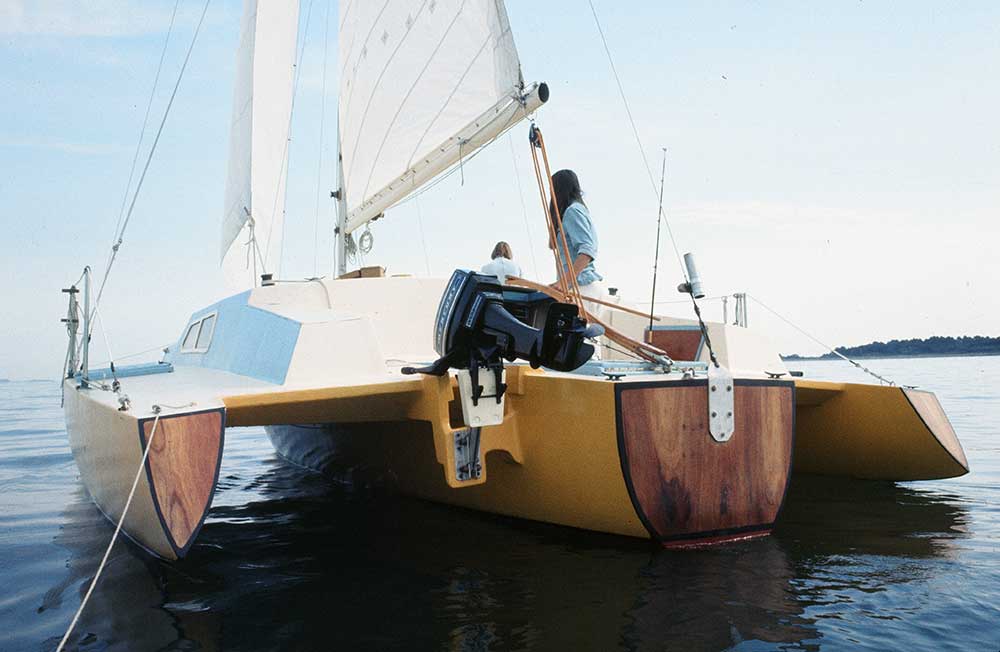
I had these plans for a 21-foot proa, and I talked to the famous multihull designer, Dick Newick, about it. And he said, “No, no, no. You don’t want to do that. You want to build a monohull.” As you shrink the size range, things like stores and crew weight amount to a much larger percentage of the hull. So, you don’t get as much bang for the buck, if you will, as you do on a bigger boat. The second thing was that I thought I could make it a lot safer (or so I thought), with watertight compartments and making a self-righting design. I also thought I could have reasonable accommodations in it. The whole idea wasn’t as a racing machine, but as a solo cruising boat. It was actually one of the best cruising boats I ever had.
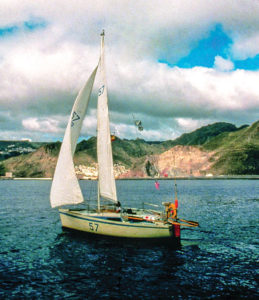 I designed it in 1978, and I made errors. I had been cold molding boats, but that process wasn’t as uniform as it is today — we didn’t know about scantlings and things like that. I should have done some things differently with Solo, and I only have myself to blame for her failure. And of course, I did blame myself for it; I beat myself up pretty badly when she went down.
I designed it in 1978, and I made errors. I had been cold molding boats, but that process wasn’t as uniform as it is today — we didn’t know about scantlings and things like that. I should have done some things differently with Solo, and I only have myself to blame for her failure. And of course, I did blame myself for it; I beat myself up pretty badly when she went down.
She handled beautifully. She was a little tender, but had a really good range of stability. And she could steer herself. Everybody goes, “Oh, fin keel boats can’t steer themselves, especially not little ones.” Our autopilots were pretty unreliable at the time, and I remember once having the boat steer itself for three days on the way to England when the autopilot went out. I didn’t touch the helm at all. I could really balance the boat and get it to go anytime the wind was around or forward of the beam. It was a really good experimental boat.
Anytime I would pull into a port, I’d wake up in the morning and all the local fishermen would be looking down at me through the hatch waiting for me to get up. They couldn’t believe that this little boat came from America. It was this wonderful welcome mat to the locals. I remember once I was tied up behind a Swan 75, and the locals would come down every night and stroll up and down the quay for entertainment. They would literally put distance between themselves and this big Swan, but as soon as they got to me they would be right over the boat wanting to talk to me. It was wonderful.
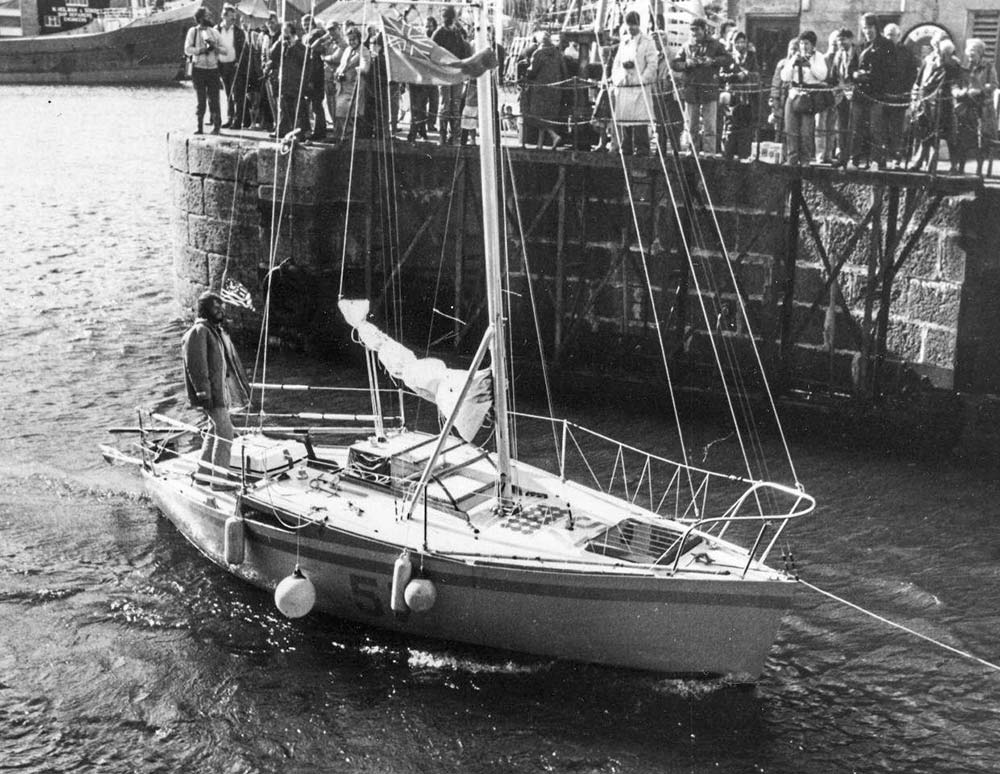
Napoleon Solo really lived up to what I wanted to do. By the time I got to England with my friend Chris, who helped me build the boat and who introduced me to Russell Brown, I had fulfilled all these childhood dreams. I was about to turn 30 years old. I wasn’t sure what was going to happen next, but I was signed up for the Mini Transat Race, which is limited to boats of that size. Today, it’s a big race that’s fully professional, and a feeder for all of the big names who are in the offshore singlehanded scene. At the time, it was a mix of amateur boats — people sailing whatever they had, old Muscadets and the like — and there were some boats that were specifically designed for it. It was such an interesting time in design, because we were really trying to sort out what works and what doesn’t. So you had a wide variety of approaches. Now, there are differences if you know what you’re looking for, but generally speaking, the boats are quite similar.
I started that race in the fall of 1981. It was very stormy. We lost a lot of boats. One sailor got killed before the race. One American sailor got caught in the hurricane and was flipped upside down 12 times. By the time he got to England he was beaten to pieces, broken ribs and everything. So he didn’t get to start. I had damage in the Bay of Biscay, so I dropped out and just kept cruising. I went down the coast of Portugal to Spain, to Madeira and then down to the Canaries.
I left on what was supposed to be the Milk Run. The trade winds take you across to the Caribbean. I figured I’d go visit my buddy who lived there, and see if he could give me some work because I was totally broke. Everything I had was in that boat. But, it wasn’t to be.
What kind of repairs did you have to do in advance of the trip across to the Caribbean, after the Mini Transat experience?
They weren’t permanent repairs. I had some cracks in the hull, actually, just below the sheer. It was kind of an open plan boat. I had major bulkheads and stuff, but also big open spaces. I should have built the bulkheads a lot tougher and put stringers into it. The Bay of Biscay is pretty nasty, but we’d already been across the Atlantic. I’d already been through several gales with the boat at that point. We got knocked down over 90-degrees once. Green water was over the hatch, but we popped back up and everything seemed fine. The boat was pretty tough. But especially going to weather over these big waves — bam, bam, bam…. I don’t know if I hit something in the water, some kind of flotsam, there were streaks in the hull. There’s tons of stuff out there as most people know, especially out in your area with logs. I think I probably should have used a different wood in the construction, too. Anyway, I reinforced the sheerline crack and a few others. I got some glass in Spain, glassed it all up and it seemed ok all the way down to the Canaries.
The night I lost the boat, it was blowing. I’m pretty cautious generally. I’m constantly looking around the boat. The best thing to do is preempt things and always look for where potential problems might be. So, I’m up every hour looking at all the joints and making sure everything is ok. I laid down finally to go to sleep and stupidly took all my clothes off except a t-shirt.
And then… BAM! And the rest, they say, is history.
You’ve written an acclaimed book about what followed, so we clearly won’t get the full story in an interview, but how do you sum up the experience for those who are unfamiliar?
The briefest summary is that something hit the boat, pretty hard — my best explanation is a whale, but we’ll never know. There’s lots of big stuff in the ocean. I think it was something moving through the water. It seemed to come from the leeward side and push me up to windward a bit. It was a huge crash, and the boat was holed.
I bailed out into a standard six-person Avon life raft, which is not quite big enough in diameter on the inside for me to lie flat (I’m 5’10”). I spent the next two-and-a-half months drifting across the Atlantic and learning to live like an aquatic caveman. Everything that floats in the ocean is really a little island. At first, it is a new island, but eventually it develops this whole ecosystem. We see light bulbs float that grow weeds and barnacles. For whatever reason, fish tend to school around these objects.
That’s what we rely on as ocean survivors. Eventually, I learned to live off the environment, as did the people before me — Maurice and Maralyn Bailey, for example, and Dougal Robertson and his family who were adrift in the Pacific for 38 days and wrote Survive the Savage Seas. I actually carried a survival manual written by Dougal, for which I was very thankful because it gave me a lot of practical advice. He and his family were real inspirations.
I had traveled the world enough to realize that a lot of people spend their entire lives in survival mode. At least I could see if I’m making progress on the raft — if I could hang on long enough, this was going to end. That was really inspiring.
One of the famous parts of your story is that after you had abandoned ship into the life raft, you realized that your ditch bag was still in the boat, and you had to make several dives back into the boat to retrieve some essentials. Was that survival resources book in the ditch bag?
I had been in a life raft before — not under fire — with our 28-foot trimaran. One of my first offshore trips was a Bermuda Race. Three of us got in a four-person life raft and we looked at each other and said, “I hope like hell we’re never in one of these things.” So I knew enough to realize that there was not that much room for equipment in a life raft. You want something the size of a pack of cards, and when you pull the ripcord and have the QE2 inflate next to you. Weight, size, and cost keep gear packages for life rafts pretty basic. Most people are picked up within 48 hours — very few people drift around for weeks and weeks and weeks, but it does happen.
I was pretty serious about it, and I had this specially made duffel bag with extra watermakers and the manual, and little pads of paper and pencil (which I still consider one of my most important pieces of survival gear), knives — all the essential stuff that I can use to solve problems.
When the boat first went down, it was nose down and completely underwater. Because I had built watertight compartments and an airlock had formed in the back of the boat, the stern was sticking up a bit. Even though every wave was burying the whole boat and I wasn’t sure how long it was going to stay afloat, I had a chance to get back on board and get some really vital gear. I was hoping to stay with the boat until at least daylight to get some food and more water, which I had in five gallon jugs, but I got separated from the boat just before dawn.
One of the concepts about survival — and probably life in general — is that there’s a yin-yang kind of balance to everything. And you can look at anything as a blessing or a curse, and sometimes there’s a little bit of both. Breaking away from Napoleon Solo was heartbreaking, but being tied to it was like being tied to the world’s best sea anchor in this light, bobbly life raft that was getting absolutely pounded by breaking waves. It was like being in an auto accident every few minutes. I was really worried about the raft being ripped apart. In a way, it was kind of a blessing that I got separated when I did.
I knew that I was just about dead-smack in the middle of the Atlantic Ocean, and I wouldn’t be drifting to the Cabo Verde islands — which were a lot closer — because it was across the winds and currents. Instead, I’d be drifting downwind 1,800 nautical miles or so to the Caribbean Islands, if I was lucky.
Fortunately, I was very lucky and moved pretty steadily toward the Caribbean every day, with one 24-hour period when I got blown into a little circle and then continued on my way. Again, the blessings and/or curses — I couldn’t have gone any direction further without hitting something; yet on the other hand I was in steady winds and steady currents carrying me ever forward, so I could measure this little distance on the chart every day.
You told me you think of every sailing experience as a survival experience. Of all sailing pursuits, solo offshore voyaging is perhaps closest to that survival experience. In what ways are you particularly well suited to offshore voyaging in the first place? And how had solo offshore voyaging prepared you for the Adrift experience?
I’m not so sure I am particularly suited to singlehanded sailing. I’m not the world’s most experienced sailor, but I’ve done seven ocean crossings and scores of other offshore passages. Out of that, only a handful were singlehanded. Most of my trips have been with one or two other people — like my wife Kathy, who is a great companion aboard, or my friend Chris who helped me build Napoleon Solo.
I find that a lot of people on the boat can be as much of a challenge as having nobody aboard. It depends on who it is. The trip I did with the biggest crew was part of the BT Challenge from Cape Town to Boston with a crew of 13. I was actually a little freaked out even thinking about it before I got there. Fortunately, I found the whole crew delightful, really interesting characters. So that was a good experience. I’ve enjoyed being with people on board, generally, but I like to have the boat not too crowded
It is a strain being shorthanded. I think I’m a pretty self-reliant person. As a generalist, I like doing everything. I remember doing ¾ Ton North Americans and everybody was so specialized — this person trims the sails, this person navigates — and that was weird to me. I like everybody on board to be able to do everything, everyone can be the captain. If the captain goes overboard, guess what, they’re going to have to be.
I think it just suits me to be shorthanded. I always loved the shorthanded offshore racing scene, because I’m techy enough that I’m really interested in development. If you think about cruising boats today — sheet stoppers, self-tailing winches, roller furling, self-steering gear. You can go down the list of virtually every modern development in boat design; and if it didn’t have its direct roots in that scene, it certainly was first refined in that scene. That very much interested me.
Of course, I tremendously admire these people who can take off in a boat and drive themselves like crazy for months on end. I’ve done enough singlehanded and doublehanded Bermuda races; and I did a TWOSTAR in 1986, which is doublehanded across the Atlantic… It is tough! How people like Ellen Macarthur can do this stuff is just mind boggling to me. When I did the TWOSTAR, a headsail weighed 300 lbs., and you’re out there trying to hump this thing around when it’s full of water. It ain’t easy. It’s like being in an almost-unending marathon. When I did it, I was in really good shape.
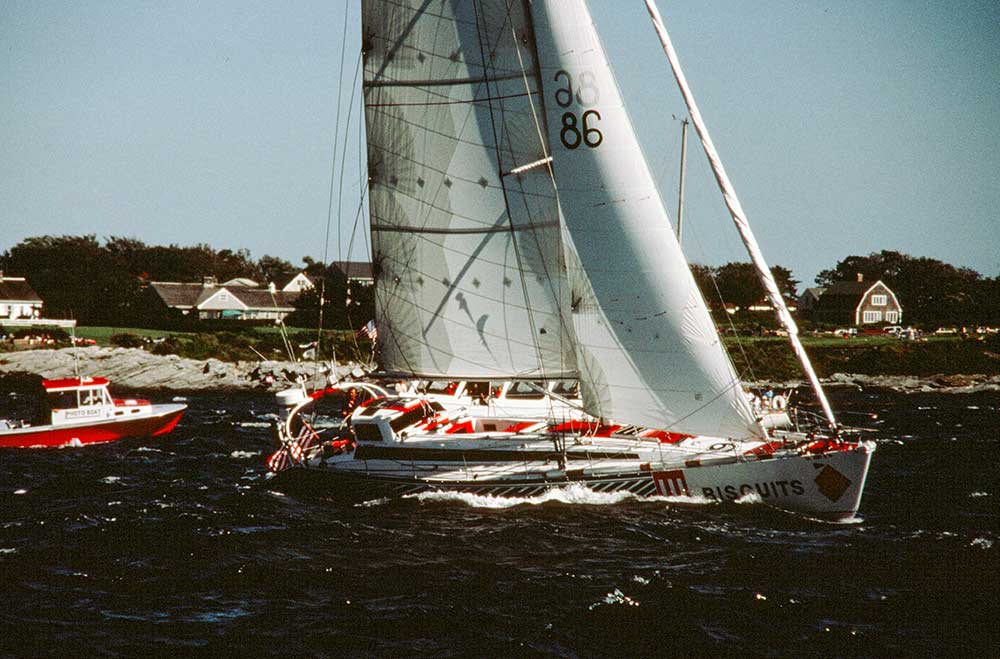
But you were singlehanded for your Mini Transat attempt, and when you were cruising afterward. And obviously, you were alone in the raft.
Again, that is kind of a split thing. There were a lot of times where I regretted being by myself. There were all kinds of problems that I was confronting and I didn’t necessarily have the right answer, or I wasn’t smart enough to have the right answer.
I did a radio program some years after coming back, and I was explaining how the fish were so smart and how I was never able to catch them by my line. A dorado would come up and bite the line off. Then I remembered I had a piece of wire in my ditch kit that was on the radar reflector, so I made a hook. I’d get a fish hooked, and it would swim really fast forward and bite the line off, and now I don’t have any more wire! So on that radio program, a 10-year-old kid calls up and said, “Hey, I read your book, and didn’t you say there was a light on the top of the raft?” I say, “Yeah.” He goes, “well didn’t you say that was driven by batteries that get soaked by water and produced the current up to it?” I said, “Yeah.” “Well wasn’t there a piece of wire between the two?” No adult had ever brought that up to me. I felt like a complete dunderhead, of course.
So, there were times I missed that feedback from other people. But at the same time, I was using these very primitive solar stills that were produced during the second World War. I’d read lots of books that had mentioned them and talked to World War II survivors, and I never found anybody else who has actually gotten one to work in the real world. I was able to get them to work, but they were producing only a pint of water per day, which is enough for maybe one person. I had almost no rainfall. So, if there had been two of us, at least one of us would have died. You take what you can get.
I’m older and I’ve had a lot of health problems the last decade, and Kathy and I have a couple of mantras which also fit my experience at sea. One is: move forward, at least when you can. The other is: be thankful for what you’ve got, and try not to be too regretful of the things you don’t.
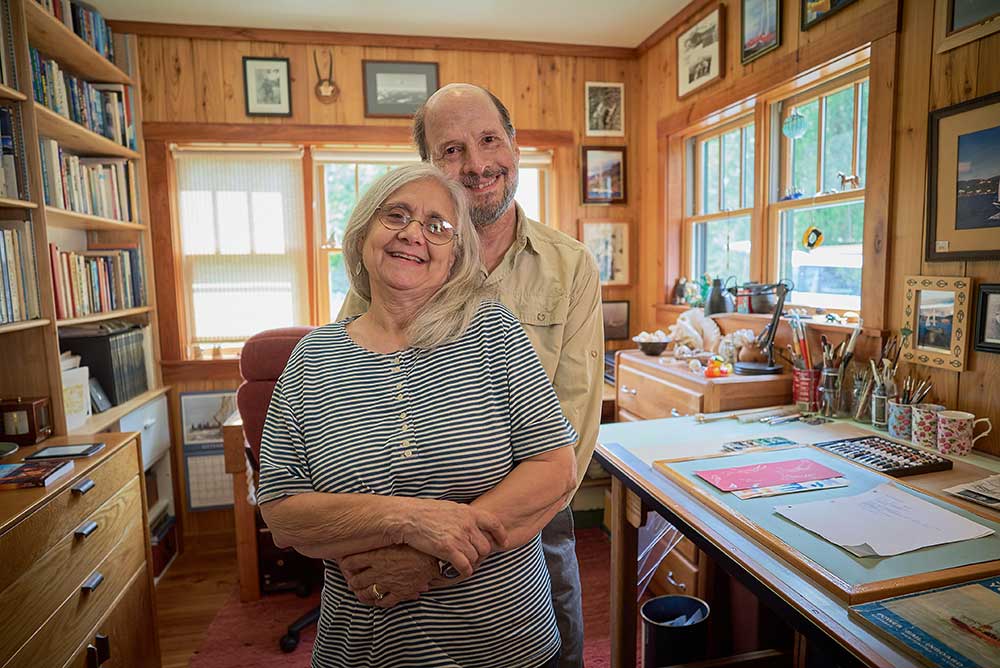
Don’t miss next month, where we’ll publish more of the interview with Steve. It’ll have more details about his Adrift experience, and he’ll share some of his ideas about the stages of survival, and the associated survival mindset and philosophy.
Joe Cline
Joe Cline has been the Managing Editor of 48° North since 2014. From his career to his volunteer leadership in the marine industry, from racing sailboats large and small to his discovery of Pacific Northwest cruising —Joe is as sail-smitten as they come. Joe and his wife, Kaylin, have welcomed a couple of beautiful kiddos in the last few years, and he is enjoying fatherhood while still finding time to make a little music and even occasionally go sailing.

